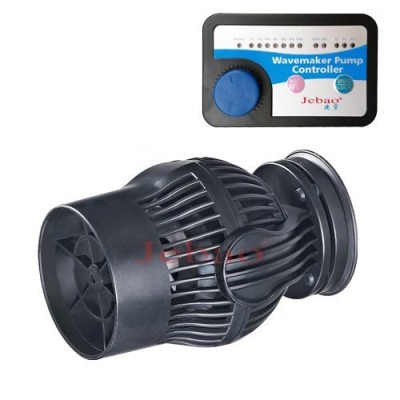Pond Pumps Canada is part of the Amazon Affiliate Network. We may receive payment for items purchased through the Amazon website.
How to use: Press the 'MODE' button to cycle through the selection of functions. H: High, constant, non-variable flow (5,300 gph) L: Low, constant, non-variable flow at a third of the speed (2,600 gph) W1: Short pulses which, when timed correctly will create a back and forth motion and form a gentle standing wave in your tank. Adjust the controller to change the speed of the pulses and vary the size of the wave according to your tank. W2 & W3: Pump gradually speeds up and slows down incrementally to create a varied flow pattern. Adjustable to form the wave best suited to your tank. Else: Reef Stream Mode, a mixed, changing pattern that creates a random flow cycle similar to what you would find in a natural reef. Feed: Press the 'FEED' button once, the blue '10min' light will illuminate indicating that the pump has been stopped for 10 minutes. When the time has elapsed, the light will go off and the pump will be turned back on. Alternatively, press the 'FEED' button again to start the pump.\n\nLock: To prevent changes from inadvertently occurring by accidentally knocking the adjustable control knob, press and hold the 'FEED' button for 5 seconds. The red 'LOCK' light will illuminate and the control knob will no longer function. Press and hold the 'LOCK' light for a further 5 seconds to disable this feature. *Night: When the two-pinned sensor is inserted into the two small plugs on the left-hand side of the control box, Night mode will function automatically. The sensor detects when the tank lights go out and slows the pump to half speed. The 'Sensor' light will illuminate when Night mode is in operation. To disable the Night mode function, remove the sensor from the control box.
- High performance, powerful, water flow combined with low energy consumption
- Low voltage, safe, reliable power supply
- Ceramic shaft for long life and durability
- 360 degree rotation on a magnetic bracket
- Fully adjustable flow that you control
Jebao WP-60 Wavemaker with Controller, 2600gph to 5300gph
- Brand: Jebao
- Product Code: WP-60
- Availability: In Stock
Dynamic Head
The effect of the Earths gravity on the "lift" or head pressure is fairly simple; for every vertical foot of distance the pump moves the water you are adding one foot of head pressure so the ratio is a 1:1 ratio. The effects of the friction, caused by water as it travels through your hose or pipes, on the total head pressure is a little more difficult to calculate especially as there are slight variations in pipe friction in different hose materials and the smoothness of the inner bore. Basically. for every ten feet of pipe through which the water has to travel travel horizontally will contribute 1 foot of head height; the ratio of the pipe friction loss is a 10:1 ratio.Plumbing fixtures and bends and corners in your hose also increase the total head you must calculate to ensure the proper final volume from your pump. Every corner with a 90 degree elbow in your plumbing will add 1 foot of head pressure with a 1:1 ratio. 45 degree elbows, tees and even insert couplers can all have an impact on the final flow.
If you install a pump 40 feet away from the top of your waterfall which is 6 feet above the pump and the tubing is a single run of 40 feet horizontally then you add 4 feet of head for the tubing length (the 10:1 ratio) to the 6 foot differnetial between the pump location and the final height of the waterfall so your final total dynamic head calculation would be 10 feet. This means your final volume of water flow in this water feature or application would be the volume of flow on the performance curve that equaled the gallons per hour at 16 feet. This volume will certainly be much less than the initial volume the pump can move at an open flow or a zero head.
If in the above example your 40 feet of horizontal tubing run also required 3 elbows of 90 degrees then an additional 3 feet of theoretical head would be added and your final flow result would be at 19 feet on the performance curve of the pump. In this example you would want to choose a pump that has the desired GPH rating at 9 feet of head pressure. Tubing size is also an important factor in accounting for head pressure loss, in general you should never reduce the diameter of the tubing below what the output size of the pump is, this will drastically increase head pressure, and reduce pump performance. For maximum pump performance, using the largest tubing that is practical is the best choice. A best practice is to use a hose with an inner diameter that is the same as your pumps outlet fitting.

